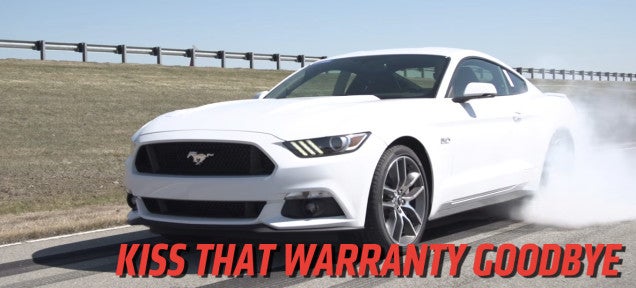 "Turbineguy: Nom de Zoom" (will-alib)
"Turbineguy: Nom de Zoom" (will-alib)
04/25/2014 at 13:03 • Filed to: None
 0
0
 15
15
 "Turbineguy: Nom de Zoom" (will-alib)
"Turbineguy: Nom de Zoom" (will-alib)
04/25/2014 at 13:03 • Filed to: None |  0 0
|  15 15 |
I asked in FP comments on the 2015 Mustang warranty piece (thanks all for the 200 recommendations! Wooo!) but got no responses, so here goes again. How does an IRS-equipped Mustang do burnouts without massive wheel hop? I thought that was one of the big issues with ind rear suspension? What sorcery did Ford resort to in fixing this?

 Cherry_man1
> Turbineguy: Nom de Zoom
Cherry_man1
> Turbineguy: Nom de Zoom
04/25/2014 at 13:08 |
|
Same way carburetors work.
 RamblinRover Luxury-Yacht
> Turbineguy: Nom de Zoom
RamblinRover Luxury-Yacht
> Turbineguy: Nom de Zoom
04/25/2014 at 13:09 |
|
Wheel hop isn't really tied to unsprung weight or similar alone - it's a mix of different things. Low unsprung weight + ability to move forward and backward + poor damping + flexing of components + other things. If you try to burn out with something featuring really cheap shitty leaf/hotchkiss setup, well...
I tried to pull up the Oppo post I wanted, but it's gone bye-bye (despite being shared to the FP in December). Just look up "holden axle tramp".
 anothermiatafanboy
> Turbineguy: Nom de Zoom
anothermiatafanboy
> Turbineguy: Nom de Zoom
04/25/2014 at 13:10 |
|
Limited slip diff would help I believe.
 HammerheadFistpunch
> Turbineguy: Nom de Zoom
HammerheadFistpunch
> Turbineguy: Nom de Zoom
04/25/2014 at 13:12 |
|
Well I know the GM team curbed their axle tramp issues with the 2nd gen CTS-V by using asymmetrical axle shafts (diameter not length). Subsequently all GM high-po vehicles use this trick now that was originally thought up for the C6 corvette.
 offroadkarter
> anothermiatafanboy
offroadkarter
> anothermiatafanboy
04/25/2014 at 13:13 |
|
limited slips don't effect axle hop, its all in the suspension design
 anothermiatafanboy
> offroadkarter
anothermiatafanboy
> offroadkarter
04/25/2014 at 13:17 |
|
Interesting. I guess im not too familiar with axle hop and what causes it..
 Mattbob
> Turbineguy: Nom de Zoom
Mattbob
> Turbineguy: Nom de Zoom
04/25/2014 at 13:22 |
|
Differential equations.
 BaconSandwich is tasty.
> Cherry_man1
BaconSandwich is tasty.
> Cherry_man1
04/25/2014 at 13:44 |
|
So... witchcraft?
 Ducky
> Cherry_man1
Ducky
> Cherry_man1
04/25/2014 at 13:49 |
|
PV=nRT?
 Cherry_man1
> BaconSandwich is tasty.
Cherry_man1
> BaconSandwich is tasty.
04/25/2014 at 13:54 |
|
Yes
 Cherry_man1
> Ducky
Cherry_man1
> Ducky
04/25/2014 at 13:55 |
|
Witchcraft and Black magic and Blood Magic all with in the Presence of the Marker
 OkCars- 22k Crossroads
> Turbineguy: Nom de Zoom
OkCars- 22k Crossroads
> Turbineguy: Nom de Zoom
04/25/2014 at 14:14 |
|
As far as i know axle hop only affects live axles
 Turbineguy: Nom de Zoom
> OkCars- 22k Crossroads
Turbineguy: Nom de Zoom
> OkCars- 22k Crossroads
04/25/2014 at 14:24 |
|
I was referring to wheel hop, which after reading a bit seems pretty common in cars with IRS. Got some good responses though, which answered my question.
 Turbineguy: Nom de Zoom
> Mattbob
Turbineguy: Nom de Zoom
> Mattbob
04/25/2014 at 14:25 |
|
Oy. Math has come back to haunt me..
 LuczOr
> Turbineguy: Nom de Zoom
LuczOr
> Turbineguy: Nom de Zoom
04/25/2014 at 15:26 |
|
Wheel hop is simply a type of damped driven harmonic oscillation. Any engineering graduate should have had plenty of practice with the differential equations that govern this.

This is the likely culprit. This equation gives a sinusoidal input for the oscillations. Engineers would assume sinusoidal input to account for drivetrain windup/unwind. It tells you that you have to reduce the amplitude of the sin wave input (stiffen your drivetrain) and increase the damping coefficient (better shocks, yo) to reduce Mr. dx/dt (the hops).